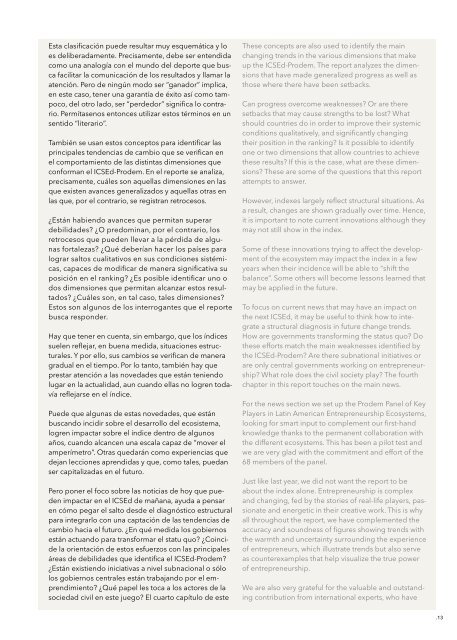Condiciones Sistémicas para el Emprendimiento Dinámico
Informe-2015-11
Informe-2015-11
You also want an ePaper? Increase the reach of your titles
YUMPU automatically turns print PDFs into web optimized ePapers that Google loves.
Esta clasificación puede resultar muy esquemática y lo<br />
es d<strong>el</strong>iberadamente. Precisamente, debe ser entendida<br />
como una analogía con <strong>el</strong> mundo d<strong>el</strong> deporte que busca<br />
facilitar la comunicación de los resultados y llamar la<br />
atención. Pero de ningún modo ser “ganador” implica,<br />
en este caso, tener una garantía de éxito así como tampoco,<br />
d<strong>el</strong> otro lado, ser “perdedor” significa lo contrario.<br />
Permítasenos entonces utilizar estos términos en un<br />
sentido “literario”.<br />
También se usan estos conceptos <strong>para</strong> identificar las<br />
principales tendencias de cambio que se verifican en<br />
<strong>el</strong> comportamiento de las distintas dimensiones que<br />
conforman <strong>el</strong> ICSEd-Prodem. En <strong>el</strong> reporte se analiza,<br />
precisamente, cuáles son aqu<strong>el</strong>las dimensiones en las<br />
que existen avances generalizados y aqu<strong>el</strong>las otras en<br />
las que, por <strong>el</strong> contrario, se registran retrocesos.<br />
¿Están habiendo avances que permitan superar<br />
debilidades? ¿O predominan, por <strong>el</strong> contrario, los<br />
retrocesos que pueden llevar a la pérdida de algunas<br />
fortalezas? ¿Qué deberían hacer los países <strong>para</strong><br />
lograr saltos cualitativos en sus condiciones sistémicas,<br />
capaces de modificar de manera significativa su<br />
posición en <strong>el</strong> ranking? ¿Es posible identificar uno o<br />
dos dimensiones que permitan alcanzar estos resultados?<br />
¿Cuáles son, en tal caso, tales dimensiones?<br />
Estos son algunos de los interrogantes que <strong>el</strong> reporte<br />
busca responder.<br />
Hay que tener en cuenta, sin embargo, que los índices<br />
su<strong>el</strong>en reflejar, en buena medida, situaciones estructurales.<br />
Y por <strong>el</strong>lo, sus cambios se verifican de manera<br />
gradual en <strong>el</strong> tiempo. Por lo tanto, también hay que<br />
prestar atención a las novedades que están teniendo<br />
lugar en la actualidad, aun cuando <strong>el</strong>las no logren todavía<br />
reflejarse en <strong>el</strong> índice.<br />
Puede que algunas de estas novedades, que están<br />
buscando incidir sobre <strong>el</strong> desarrollo d<strong>el</strong> ecosistema,<br />
logren impactar sobre <strong>el</strong> índice dentro de algunos<br />
años, cuando alcancen una escala capaz de “mover <strong>el</strong><br />
amperímetro”. Otras quedarán como experiencias que<br />
dejan lecciones aprendidas y que, como tales, puedan<br />
ser capitalizadas en <strong>el</strong> futuro.<br />
Pero poner <strong>el</strong> foco sobre las noticias de hoy que pueden<br />
impactar en <strong>el</strong> ICSEd de mañana, ayuda a pensar<br />
en cómo pegar <strong>el</strong> salto desde <strong>el</strong> diagnóstico estructural<br />
<strong>para</strong> integrarlo con una captación de las tendencias de<br />
cambio hacia <strong>el</strong> futuro. ¿En qué medida los gobiernos<br />
están actuando <strong>para</strong> transformar <strong>el</strong> statu quo? ¿Coincide<br />
la orientación de estos esfuerzos con las principales<br />
áreas de debilidades que identifica <strong>el</strong> ICSEd-Prodem?<br />
¿Están existiendo iniciativas a niv<strong>el</strong> subnacional o sólo<br />
los gobiernos centrales están trabajando por <strong>el</strong> emprendimiento?<br />
¿Qué pap<strong>el</strong> les toca a los actores de la<br />
sociedad civil en este juego? El cuarto capítulo de este<br />
These concepts are also used to identify the main<br />
changing trends in the various dimensions that make<br />
up the ICSEd-Prodem. The report analyzes the dimensions<br />
that have made generalized progress as w<strong>el</strong>l as<br />
those where there have been setbacks.<br />
Can progress overcome weaknesses? Or are there<br />
setbacks that may cause strengths to be lost? What<br />
should countries do in order to improve their systemic<br />
conditions qualitativ<strong>el</strong>y, and significantly changing<br />
their position in the ranking? Is it possible to identify<br />
one or two dimensions that allow countries to achieve<br />
these results? If this is the case, what are these dimensions?<br />
These are some of the questions that this report<br />
attempts to answer.<br />
However, indexes larg<strong>el</strong>y reflect structural situations. As<br />
a result, changes are shown gradually over time. Hence,<br />
it is important to note current innovations although they<br />
may not still show in the index.<br />
Some of these innovations trying to affect the dev<strong>el</strong>opment<br />
of the ecosystem may impact the index in a few<br />
years when their incidence will be able to “shift the<br />
balance”. Some others will become lessons learned that<br />
may be applied in the future.<br />
To focus on current news that may have an impact on<br />
the next ICSEd, it may be useful to think how to integrate<br />
a structural diagnosis in future change trends.<br />
How are governments transforming the status quo? Do<br />
these efforts match the main weaknesses identified by<br />
the ICSEd-Prodem? Are there subnational initiatives or<br />
are only central governments working on entrepreneurship?<br />
What role does the civil society play? The fourth<br />
chapter in this report touches on the main news.<br />
For the news section we set up the Prodem Pan<strong>el</strong> of Key<br />
Players in Latin American Entrepreneurship Ecosystems,<br />
looking for smart input to complement our first-hand<br />
knowledge thanks to the permanent collaboration with<br />
the different ecosystems. This has been a pilot test and<br />
we are very glad with the commitment and effort of the<br />
68 members of the pan<strong>el</strong>.<br />
Just like last year, we did not want the report to be<br />
about the index alone. Entrepreneurship is complex<br />
and changing, fed by the stories of real-life players, passionate<br />
and energetic in their creative work. This is why<br />
all throughout the report, we have complemented the<br />
accuracy and soundness of figures showing trends with<br />
the warmth and uncertainty surrounding the experience<br />
of entrepreneurs, which illustrate trends but also serve<br />
as counterexamples that h<strong>el</strong>p visualize the true power<br />
of entrepreneurship.<br />
We are also very grateful for the valuable and outstanding<br />
contribution from international experts, who have<br />
.13


